
- •Section b gasoline (petrol) engines
- •Section c diesel engines
- •Section b water and its boiling point
- •C) molecules in motion
- •Section d engine-cooling system
- •Section b lubrication
- •Section c engine lubricating system
- •Section d filters
- •Unit four electricity Section a electrolysis
- •Uses of Electrolysis
- •Section b batteries
- •Section c automobile electric system
- •Section d battery-powered automobiles
- •Section b ferrous metals
- •Tensile strength and hardness section c
- •Section d aluminium bronze
- •Grammar exercises
- •Unit 1 advantages and disadvantages of diesel engines
- •Unit 2 comparative characteristics diesel and gasoline engines
- •Unit 3 basic parts of the automobile
- •Unit 4 where diesel engines are used
- •Unit 5 Temperature Regulators of Cooling System
- •In machihes and machinery.
- •Unit 8 the instruments in a car
- •Unit 9 Battery chargers
- •Vocabulary Список сокращений
- •Literature used
- •Contents
Федеральное агентство по образованию
Архангельский государственный технический университет
АВТОМОБИЛЬ
Учебно-методическое пособие по английскому языку
для студентов механического факультета
специальности 150200 (190601.65)
«Автомобили и автомобильное хозяйство»
Архангельск
2005
Рассмотрено и рекомендовано к изданию методической комиссией механического факультета Архангельского государственного технического университета 21.09.2005г.
Составитель Э.М. Воробьева, ст. преподаватель
Рецензент И.Н. Попова, ст. преподаватель
УДК 811.111:62933
ББК81.2А англ. - 923
Воробьева Э.М. Автомобиль: Учебно-методическое пособие по английскому языку для студентов механического факультета специальности 150200 (190601.65) «Автомобили и автомобильное хозяйство». - Архангельск: Изд-во АГТУ, 2005.-74 с.
Подготовлено кафедрой иностранных языков АГГУ.
Составлено в соответствии с программой курса «Английский язык для технических специальностей высших учебных заведений» по материалам из английских и американских журналов и монографий.
Предназначено для аудиторной и домашней работы с целью развития навыков чтения, перевода и устной речи по специальности.
© Архангельский государственный
технический университет, 2005
© Э.М. Воробьева, 2005
UNIT ONE
MOTOR VEHICLES
Section A
WHAT AN INTERNAL COMBUSTION ENGINE IS
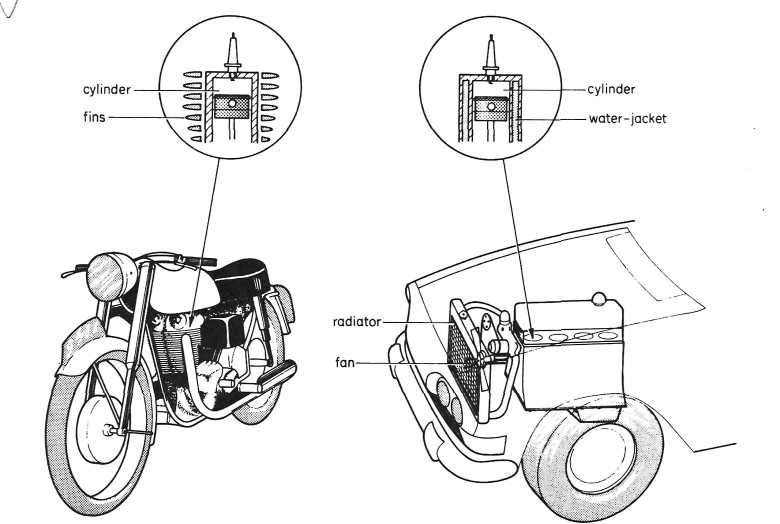
1. There is a motorcycle in the first picture. There is a car in the second picture. The motorcycle has an air-cooled engine. There is a water-cooled engine in the car.
2. The motorcycle engine has fins around the cylinders. Air-cooled engines always have these fins. There is a water jacket around the cylinders in the car engine. Water-cooled engines always have a water jacket around the cylinders.
3. There is a fan at the front of the car engine. Water-cooled engines always have a fan at the front. There is sometimes a fan at the front of air-cooled engines.
4. Water-cooled engines always have a radiator. There is no radiator on the motorcycle. Air-cooled engines never have a radiator.
5. The engine is at the front of the car. Car engines are not always at the front. They are sometimes at the back or sometimes in the middle.
Exercise 1 Are these statements true or false?
1. The car has an air-cooled engine.
2. A water-cooled engine has fins around the cylinders.
3. The car engine has a water jacket around the cylinders
4. There is a fan on the motorcycle engine.
5. There is always a fan on water-cooled engines.
6. Air-cooled engines sometimes have a fan.
7. There is a radiator on the motorcycle.
8. Cars sometimes have an engine at the back or in the middle.
Exercise 2 Look at the example. The engine is at the side of the scooter. It has one headlight at the front. The spare wheel is at the back. There is a petrol cap in the middle.
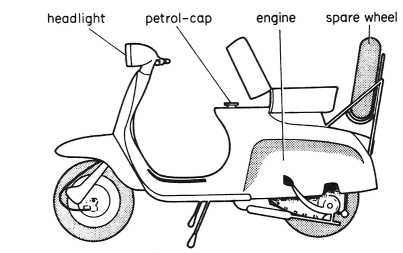
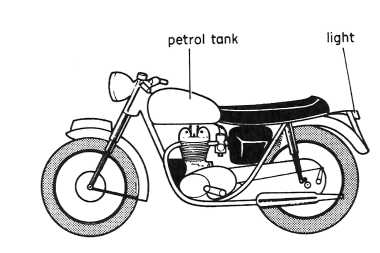
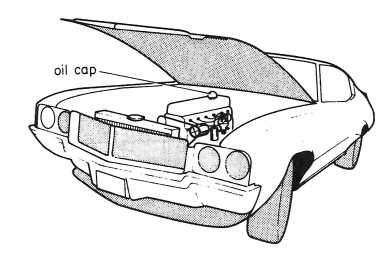
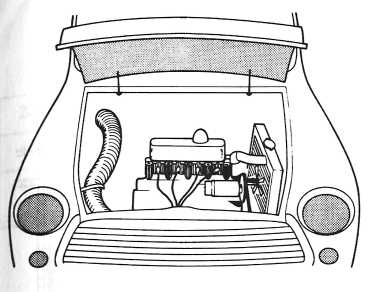
Now complete these sentences in the same way.
1. The engine is........the motorcycle. There is one headlight........ There is another light........
The petrol tank is........
2. The car has four headlights........ The engine is........ The radiator is ........ of the engine.
There is an oil cap........engine.
3 This car has the engine…… The radiator...... There is a fan.....
There is a cap.....
Exercise 3 Check up whether you know the following words (translation is given in the wordlist)
A motor vehicle, an engine, a motorcycle, a scooter, a fin, a cylinder, a jacket, a fan, a radiator, a (head)light, a wheel, air-cooled, water-cooled, spare, other, on, in, around, at the front of, at the back of, at the side of, in the middle of.
Section b gasoline (petrol) engines
In a four-stroke engine a complete cycle requires four strokes: of the piston /one up, one down, one up and one down/.
Fig. 2 is an elementary picture or .diagram which shows how a typical four-stroke petrol engine works.
Most engines have more than one cylinder but all the cylinders work alike. The picture is divided into several views, each view showing the same engine, but with its moving parts in different position. By studying the different positions in order, we shall learn how the engine works.
The Intake Stroke. The piston is at the top of the stroke or at top dead center /abbreviated TDC/. The inlet and the exhaust valves are closed. As the piston descends, the inlet valve opens and a charge of combustible mixture of petrol and air flows into the cylinder. This is called suction or induction or intake stroke.
The Compression Stroke. After the piston has reached its lowest portion or bottom dead center /abbreviated BBC/ and begins to rise again, the inlet valve is closed. As all the valves are closed, the mixture cannot escape and when the piston has reached the top of its stroke, the change is compressed. This is called the compression stroke.
The Power Stroke. When the piston once again is at its top position /TDC/, an electric spark passes between the points of a sparking plug. The spark ignites the mixture. Both valves are closed during combustion and there is a considerable pressure rise. As a result, the piston is forced back again down the cylinder. This is the expansion or power stroke.
The Exhaust Stroke. Before the piston reaches its lowest position /BDC/, the exhaust valve is opened, pressure is released. And as the piston again rises, it pushes out the residual gas. This is called the exhaust stroke.
This ends one cycle. The inlet valve opens again and the engine is ready to start on another cycle.
So there is only one power stroke for every four strokes of the piston or two revolutions of the crankshaft.
Exercise 4 Answer the following questions. You may choose the correct answer from among those given in parentheses.
When can the mixture of gasoline and air get into the cylinder?
What happens when the mixture of gasoline and air is compressed?
Does the piston move up or down when the mixture of gasoline and air is ignited?
What makes the piston move down when the mixture of gasoline and air is ignited?
When is the residual gas pushed out of the cylinder?
(1. The piston moves down when the mixture of gasoline and air is ignited. 2. It can get into the cylinder when the inlet valve opens. 3. It is pushed out when the piston moves up again. 4. When the mixture of gasoline and air is compressed an electric spark passes between the points of a sparking plug. 5. The considerable pressure rise makes it move down.)
